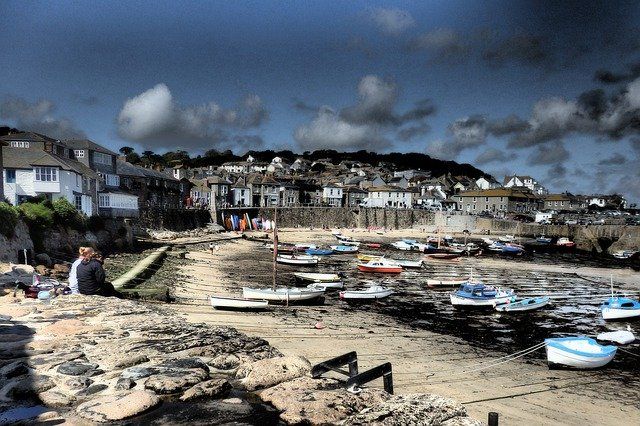Seven years after ‘The Great Revival’ of Redruth in 1814, which so extensively and profoundly affected the Methodist societies in that whole area of Cornwall, a further powerful quickening occurred in October 1821 at Camborne and Tuckingmill, just three miles from Redruth.
The remarkable conversion of two young men, who were brothers, was the divine spark which lit the fire. In his Memoir William Carvosso describes what happened:
‘Soon the prayer meetings began to increase, and the Lord poured out the Spirit of grace and supplication upon the people’. Carvosso refers to one meeting when ‘they felt so much of the overwhelming power of grace that it was some time before they had bodily strength sufficient to walk home’.
Conviction
The revival spread and, during April and May 1822, broke out at Kehelland, a mile and a half north-west of Camborne. Carvosso describes how ‘several of the Camborne friends made an appointment to go to Kehelland, to hold a prayer meeting … The power of God descended, and many sinners were pricked in the heart: this was a drop before the shower. The Lord began a gracious work among them, and some of the most wicked and notorious sinners in the neighbourhood were awakened’.
Carvosso relates several individual cases of conversion and the sovereign manner in which God dealt with their souls. The characteristics of the revival bore all the evidence of a true, powerful and effectual work of the Spirit of God.
In the years 1820-21 a general quickening within the churches had been taking place throughout the land, and many thousands were converted. In the year 1822, when the Kehelland revival broke out, as many as 12,000 were added to the Wesleyan churches.
Power
Unusual things were happening elsewhere in Cornwall. ‘The Great Revival’ of Redruth in 1814 had affected other places such as Porthleven, Breage and Ponsanooth. In 1817 the Spirit had been poured out in these places.
Contemporary accounts refer to ‘the power of God descending among us as a mighty rushing wind’ and ‘a very gracious visitation from above’. The people looked and prayed for special visitations of God. They sought a coming down from heaven to earth of the Spirit’s divine influences, to raise the level of spiritual life among the people of God. This led to many remarkable conversions and a general public awareness of the holiness and power of God.

Men of Reformed views today can ill afford to be over-critical of these Wesleyans of 150 years ago, whose views of spiritual life within the church allowed a far greater place for the intervention of God than we do in our day. Experimentally, they took far more seriously than we do, the imperative need of the sovereign activity of God in the life of the churches. We give lip-service to it, but they acted upon it.
Ponsanooth
In November 1823 a revival broke out at Constantine, five miles south-west of Falmouth, and many of the ungodly were awakened and brought into spiritual liberty through the gospel.
William Carvosso was in Constantine when the revival started, and he relates how he received news of a work of God begun in his own home town of Ponsanooth, situated between Falmouth and Redruth:
‘Hearing that God had very wonderfully visited Ponsanooth, I hastened thither, and found some of the distressed souls in the chapel, who had been there several days and nights, struggling in prayer, and crying for mercy. At Mr Lovey’s factory the Spirit of conviction was operating so powerfully, that many who had been triflers were falling down on their knees to pray in the midst of their work. But not only at Ponsanooth has this glorious work broken out: it has gone forth into all the societies and congregations around about to a great extent’.
Thousands of souls were awakened and brought into peace with God. Years later, most of those who testified to the forgiveness of sins in this revival were found continuing steadfastly in the faith.
Mevagissey
Other revivals had been breaking out elsewhere. In 1826 the St Austell Circuit experienced a divine quickening, when places such as Sticker and Charlestown were gloriously visited by the Spirit of God.
Part of the same general awakening, and yet distinct in its origin, was the revival at Mevagissey in the spring of 1827. It began with the striking conversion of a woman of eighty years of age, who had been destitute of true religion, despite having attended one of the class meetings for thirty years.

She was pricked in her heart, and fell upon her knees, and began to cry to God for mercy. ‘Lord, save me from dropping into hell!’ she cried. The Lord visited her soul, and we read: ‘Her face shone as it had been an angel, and she went round the room, clapping with her hands, and shouting the praises of God, apparently with all the activity of a girl of fifteen although she was then fourscore’. One must make allowances for the Cornish temperament!
This conversion was followed by prayer meetings held every night for seven weeks. Some amazing conversions took place. There were times when the convicting work of the Spirit was so great that the cries of the people calling upon God for mercy within their homes could be heard by those walking along the streets of Mevagissey. Upwards of one hundred and fifty of all ages were brought to the Lord.
Mylor Bridge
The Mylor Bridge and Flushing area, just north of Falmouth, had long resisted the gospel, but in the year of the Mevagissey revival 1827, it yielded. The exalted Son of God commanded his blessing, and the Spirit of the Lord was poured out upon the people. Many were awakened and converted.
The favour of God continued toward the people in the Mylor Bridge area. William Carvosso, in a letter he wrote at the end of 1833, comments, ‘I suppose you have heard how the Lord is pouring out his Spirit at Mylor Bridge. Such a sight, at this place, I have never seen before’.
Prayer meetings were held night after night for months on end. The glory and power of the revival in 1833 exceeded that of 1827. Who knows, but that God may yet work again in our nation in such a manner that the glory of the latter day shall excel all that has preceded it?
Continuous revivals
The revivals in Cornwall at this time were continuous. Beginning with ‘The Great Revival’ at Redruth in 1814 and continuing for a period of twenty years, it is a story of many revivals, here and there, in this village and in that village, sometimes the same place being visited more than once with but a few years intervening.
The church of the New Testament was in a condition of continuous revival over a period of thirty years. This is the main reason why there is so little in the New Testament on the subject of revival. The New Testament assumes such a condition and the book of Acts describes it, whilst the epistles were written generally in order to counteract influences which threatened to lead the churches away from that high level of spiritual life and experience.
The Evangelical Revival in the eighteenth century was also of a continuous character, with visitation upon visitation over a period of forty years or so. Such too, as we have seen, was the character of the work of God in Cornwall in the early nineteenth century.
Evangelism and revivals
Important lessons arise from these observations. The periods in the history of the church, when the ungodly are effectively gathered in and the world is influenced to a marked degree, are days of revival.
Apart from revivals, and their continuing repercussions in the years which follow, the church is usually found in a state of spiritual decline. It was this awareness which focused the attention of our spiritual fathers on the absolute necessity of revivals.
Solomon Stoddard, the grandfather and predecessor of Jonathan Edwards in Northampton, New England, was pastor of the church for sixty years. In that time he faithfully preached the gospel continuously; but looking back over those years was able to identify ‘five harvests’, days of divine visitation when God came and called the lost into his kingdom.
He was a Calvinist, and the Wesleyans in Cornwall were Arminians*; but what they shared in common was the view that since conversion and sanctification is a work of God, it will only take place when God is pleased to act. Therefore, they believed in, prayed for, and looked for, divine visitations to effect the work of God. We must do likewise.
*Note: In the historical sense of ‘Arminianism’ as exemplified by John and Charles Wesley. Today the term is often applied to Pelagian teaching which presents salvation as the result of man’s decision.
The Memoir of William Carvosso has recently been republished by Harvey and Tait UK. A Kindle edition is available,



